Yoga for runners: eight moves to improve flexibility and strength
Yoga for runners: the lowdown on the best yoga postures for runners
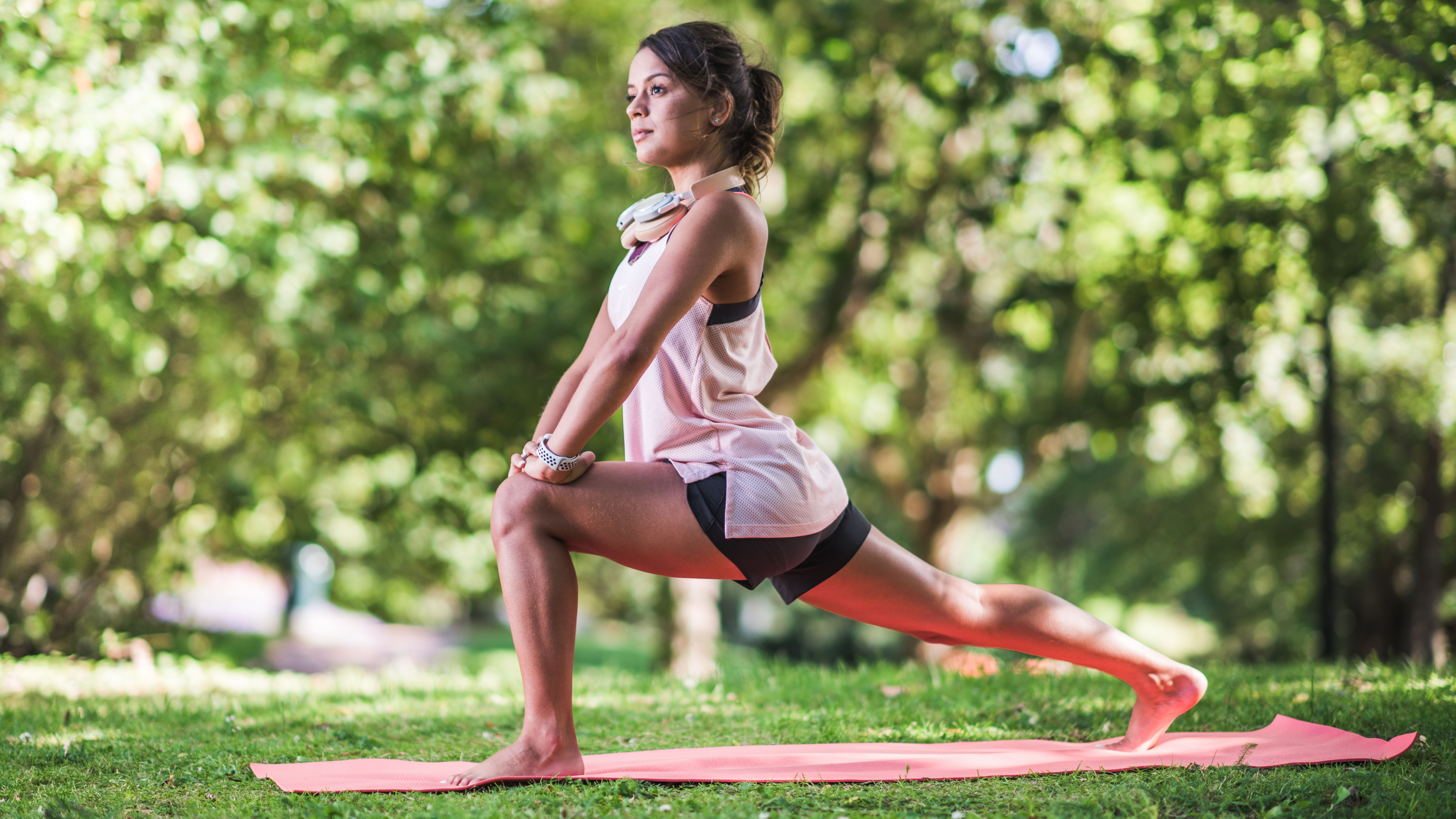
Have you ever considered yoga for runners? Yoga has many benefits that extend beyond maintaining flexibility. Yoga can help you sleep better, improve your concentration, increase your stamina, help you to build muscular strength, improve your balance and lower your resting heart rate.
All of these things can help runners perform better, with research from the International Journal of Yoga finding that yoga can actually help athletes to improve the uptake and utilization of oxygen during exercise, making the body more efficient.
Yoga is normally practiced on a yoga mat. The best yoga mats are comfortable for bonier joints and have a sticky texture to ensure you can stay firmly planted when holding postures.
But there isn’t a right or wrong when it comes to runners practicing yoga as many postures will benefit them. We’ve put together some of the best yoga postures for runners to help you get started, with the help of expert physiotherapist Kelly Rotheram.
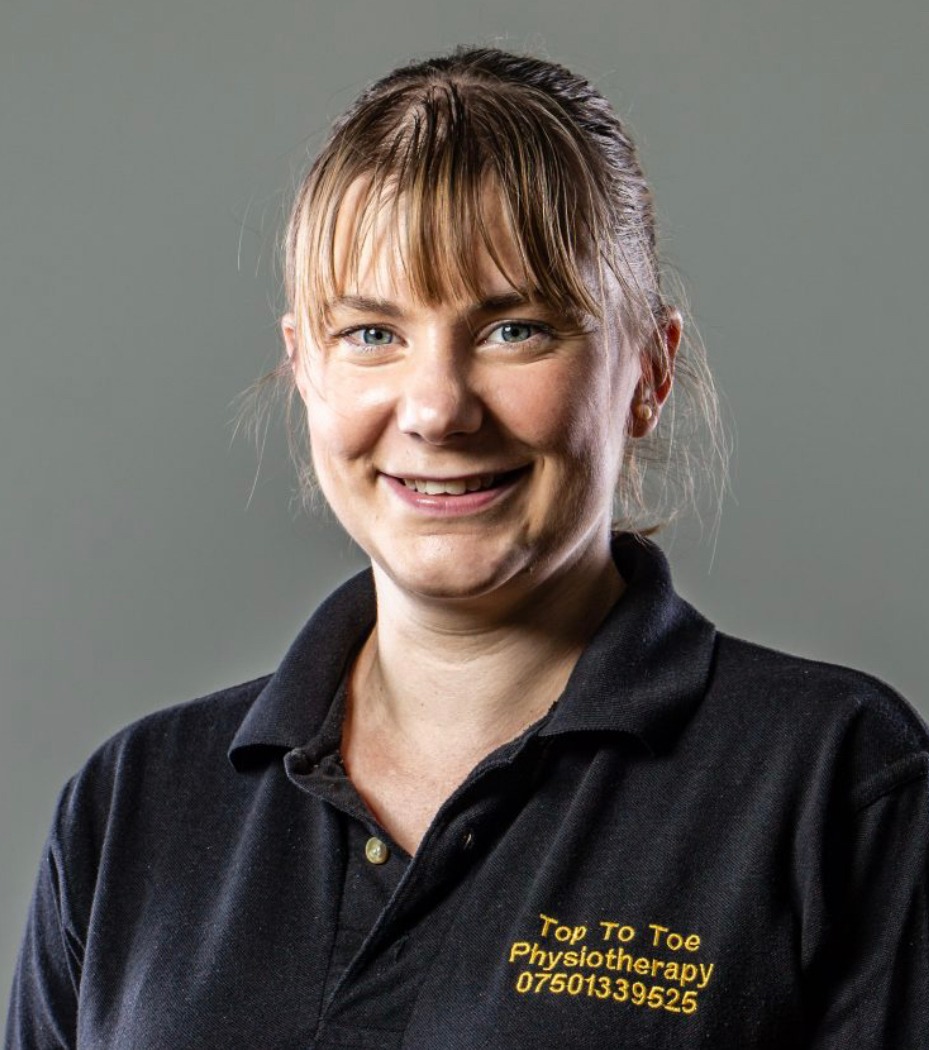
With over 15 years of experience in Physiotherapy, Kelly has a vast knowledge working with elite athletes and the general public. She is passionate about her work and takes a holistic approach with her patients as she understands both the physical and psychological impact of an injury. She's a joint owner of Top To Toe Physiotherapy and a Senior Physiotherapist.
1. Downward dog
Physiotherapist Kelly Rotheram explains why the downward dog is beneficial for runners to practice, “It works on both flexibility and strength,” she says. “Downward dog targets your upper and lower body at the same time, so you'll feel it in your arms, shoulders, back, calves, hamstrings and ankles.
“Not only does downward dog provide a great ankle and calf stretch but it also strengthens lots of smaller stabilizing muscles in the foot. To protect yourself from injury when running, you want feet that can conform to the ground, react quickly to the terrain and transfer weight effectively.”

Step 1 - From an all fours position, place your hands in front of your shoulders and tuck your toes. Spread your fingers wide.
Get the world’s most fascinating discoveries delivered straight to your inbox.
Step 2 - As you exhale, lift your hips up and back, making your spine long.
Step 3 - You can keep a bend in your knees if your shoulders round. You want to lift up and out of your shoulders, with a flat upper back, pressing the floor away from you.
Step 4 - Take 3 deep breaths here. You can stay still or walk on the spot, bending one knee at a time.
2. Low lunge
Low lunge is a must for runners. Rotherham explains: “As a runner, you can’t ignore the lunge, a movement that has various forms and significant training effects. The low lunge can train the balance and proprioception of the body and help with the mobility of your torso, hips and ankle joints. The low lunge mainly stretches the quadriceps, abdominals and hip flexors and helps strengthen the glutes.”

Step 1 - From your downward dog, step your right foot forward between the hands, dropping your left knee to the floor. Untuck your left toes.
Step 2 - You can place your hands either side of your right foot. Keep pressing into your right foot and top of your left foot while you breathe into the lunge.
Step 3 - As you press into your feet, sink your hips forward and down to stretch the quadriceps on the left leg. Take 3 deep breaths.
Step 4 - Change legs, bringing your left foot forward and right leg back and repeat.
3. Intense side stretch
Intense side stretch pose is a deep stretch, focusing not only on the legs, ankles and feet but the spine.
Rotheram provides an insight into what this pose can do for runners, “This pose relieves stiffness in the legs and hip muscles and helps with mobility in the hips and spine,” she says. “The core muscles are working while the head rests on the knees. The shoulders are drawn back, which helps correct rounded, drooping shoulders.”

Step 1 - Come to stand with your feet around a leg's distance apart. Turn your right toes out to the short side of your yoga mat and turn your left toes in towards the center of your mat.
Step 2 - Inhale and lift your arms up, turning your hips in the same direction as your right foot, and exhale fold from your hips over your right leg.
Step 3 - Place your hands onto your right shin or the floor, if you can reach. You can also use yoga blocks under the hands for support or loop your arms behind you.
Step 4 - As you take 3 deep breaths here, keep turning your left hip towards the right foot so your pelvis stays level.
Step 5 - Inhale, press firmly into your feet, engage your thighs and lift your arms up, coming to stand. Repeat on the other side.
4. Reclined hero pose
Rotherham says there are many benefits of the reclined hero pose for runners. “Reclined hero pose increases flexibility and encourages proper alignment in the hips, legs and knees. It stretches the quads, encouraging and training internal rotation whilst also strengthening the lower back,” she says.
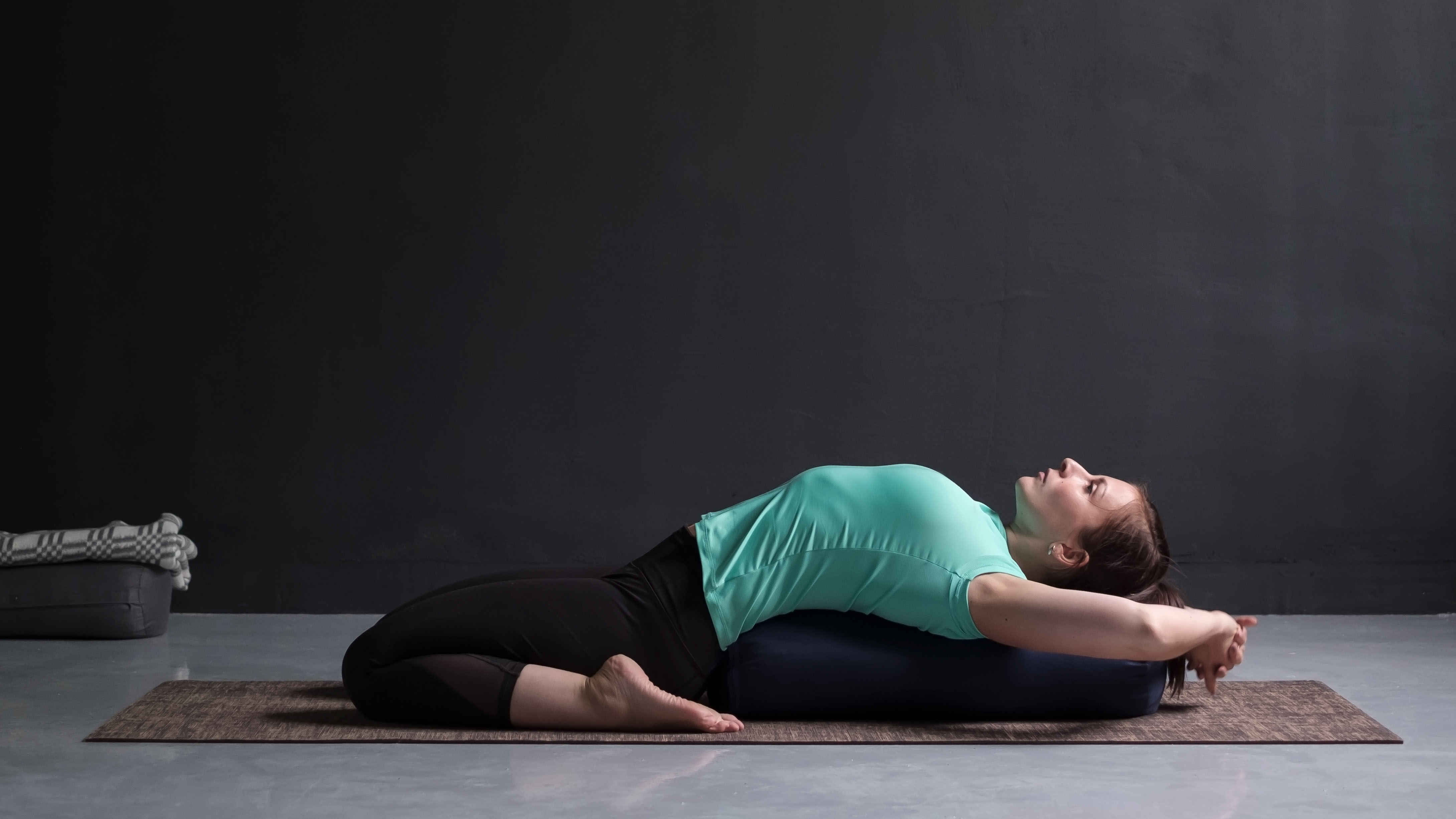
Step 1 - Come to your knees and turn your feet out wider than your hips. Your knees may or may not stay close together, do what feels best for your knees here.
Step 2 - Roll your calf muscles out with the help of your hands and sit back, between your heels. You can use a block or cushion under the buttocks here for support.
Step 3 - You can start to walk back on your hands, making sure you do not feel any pain in your knees. You want to feel a stretch on your thighs so tucking the tailbone to the backs of the knees may help with this.
Step 4 - Keep going backwards until you reach a comfortable limit. You may end up on the hands, elbows or lying all the way back. Find your variation and stay for five deep breaths.
Step 5 - To come out, walk yourself back up using your hands and lift up off your heels. Stretch your legs out and give them a shake.
5. Bridge
Bridge pose is great for stretching out after a long run and improving your hip strength. Rotheram comments: “Running can put pressure on your hips that, over time, can take its toll on your performance.
“Luckily, bridge pose is here to help you build strength in your hip muscles. We know how important the gluteal muscles are for runners too and this pose can really help to target that posterior chain. It also engages your core and stretches your hip flexors.”
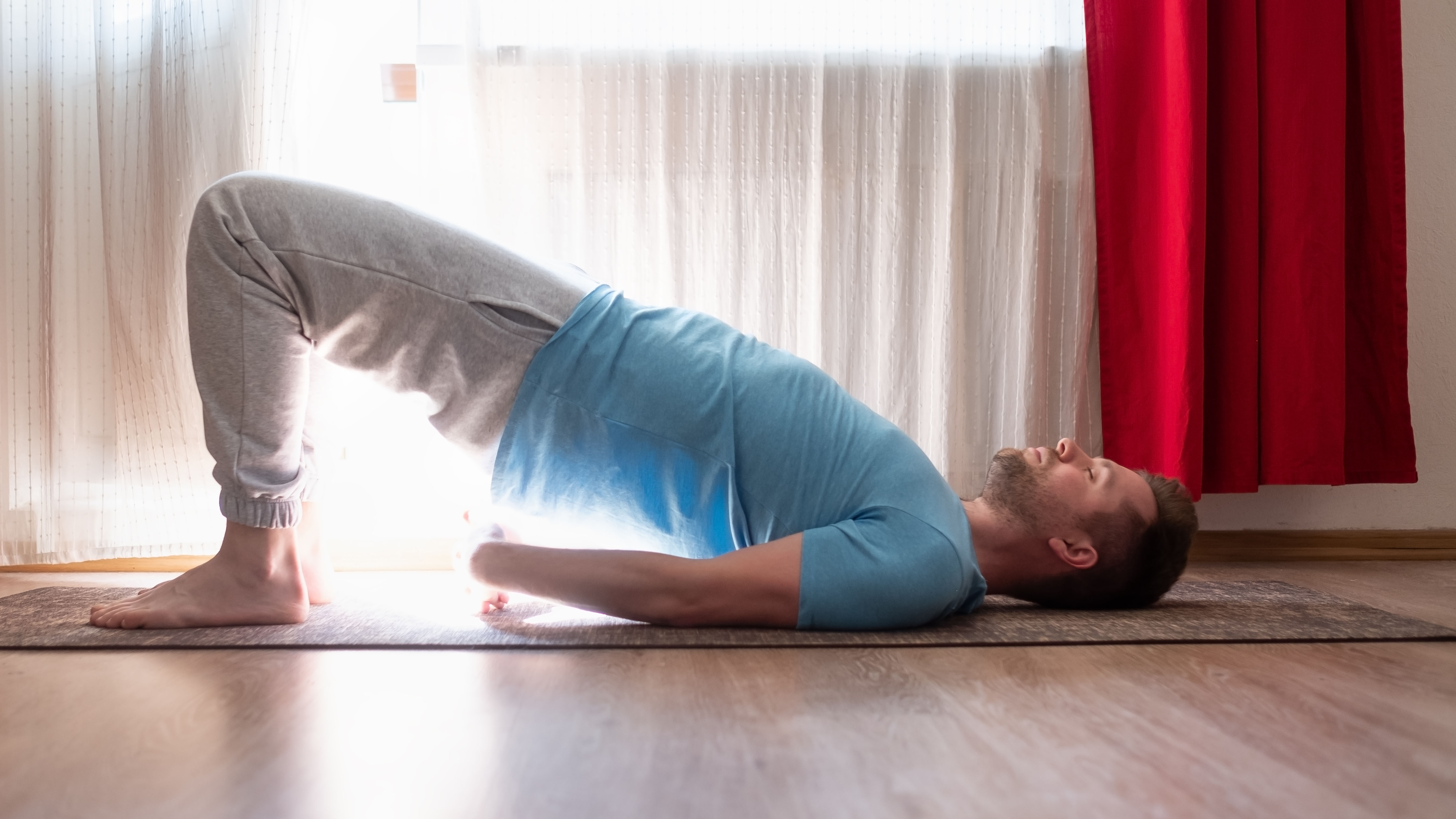
Step 1 - Come to lie on your back, with your feet on the floor close to your buttocks. You should be able to touch your heels with your middle fingers.
Step 2 - Place your arms down beside you, palms facing the floor. Press into your upper arms and forearms and start to lift the hips up as your inhale.
Step 3 - Keep tucking your tailbone to the back of your knees and lift your hips up higher. Your chest should be moving towards your throat.
Step 4 - Take 3 deep breaths here before releasing back down on an exhale. You can repeat this posture a few times.
6. Reclined pigeon pose
From a physiotherapist’s perspective, reclined pigeon pose has a host of benefits for runners.
Rotherham explains: “Reclined pigeon pose offers multiple benefits. It opens the muscles surrounding the hips, the low back, and the backs of the legs. When we don’t take the time to stretch out over-taxed areas properly, it can often lead to tightness and pain. Gently stretching these specific muscle groups will let your body heal and recover properly from overuse.
“As this pose is done on your back, it’s great to do as a warm-up pose or a cool-down pose. Since laying down doesn’t put any pressure on your hips or your knees, it’s also a safer hip-opener if you’re working with any hip instability or knee injuries.”

Step 1 - From your bridge pose, keep your feet on the floor and place your right ankle in front of your left knee.
Step 2 - Ensure your right knee is moving away from your right shoulder so you can feel a stretch in your outer right hip. You can stay here with your left foot on the floor or if you can’t feel much in your outer right hip, try the next step.
Step 3 - Inhale and lift your left foot off the floor. Thread your right arm through the center of the legs and your left arm round the left side of the left leg so you can take the back of your left thigh.
Step 4 - Take five deep breaths here before changing to repeat on the other side.
7. Toe squat
This is not everyone’s cup of tea but proves essential for runners. Rotheram explains: “Your feet and shins undergo tremendous stress with each pounding step you take when running. Stretching your toes and the soles of your feet can reduce the occurrence of plantar fasciitis, which in turn ensures your runs remain bearable. This pose also stretches the muscles and connective tissues along the tibia to help prevent and reduce the pain of shin splints.”

Step 1 - Come to sit in a kneeling position. Place your hands in front of you and lift your hips off your feet.
Step 2 - Tuck your toes under and start to bring the weight of your hips back towards your feet. For some people, they can sit on their heels with their hands on their knees. For others, having their hands on the floor and leaning forward is enough of a stretch for the feet.
Step 3 - Take five deep breaths here before you lift up and release the feet completely.
8. Head to knee pose
A good pose to get into the habit of practicing, “head-to-knee pose stretches the hamstrings, hips and groin muscles. Athletes and runners who need to run often will benefit from this excellent technique for tight hamstrings”, says Rotheram.
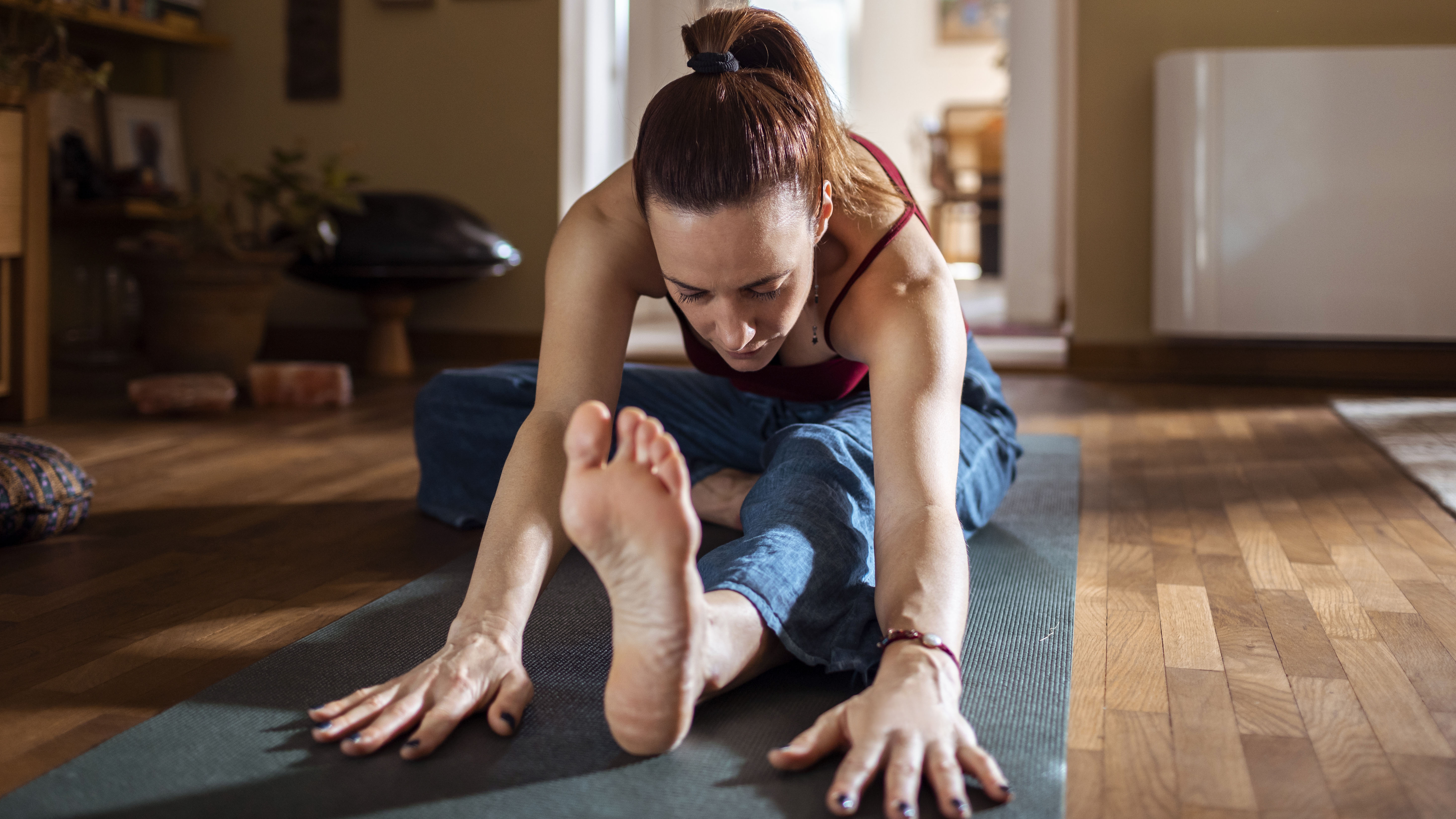
Step 1 - Come to a seated position with your legs outstretched in front of you. Bend your right knee and place your foot on the inside of your left leg.
Step 2 - Inhale and place your hands on the floor next to your hips. Lift your chest up, lengthening your spine but relaxing your shoulders down away from your ears. Exhale here and the inhale to lift the arms up overhead.
Step 3 - Exhale and fold forward, hinging from your hips over your left leg. Take three deep breaths here before changing sides.
Why should runners do yoga?
After a long run, it’s common to feel stiff. Runners are always advised to stretch before and after a run but how many actually do this?
Stretching before a run warms your muscles while stretching afterwards helps to maintain your flexibility – ignoring your post-stretch run can lead to decreased mobility over time.
There’s also the added benefit that stretching after exercise helps to get the blood flowing to the muscles to remove lactic acid. If we experience a lactic acid build up, we may feel aching or burning in our muscles. Practicing some yoga after a run can be a great way to start the healing process for your tired legs.
“Running is repetitive in nature,” says expert physiotherapist, Kelly Rotheram. “This can cause musculoskeletal imbalances in flexibility or strength. Yoga helps restore symmetry and balance to the body by improving flexibility and strength in the muscles and provides a full body workout. Muscles especially in the arms and upper torso not usually used in running are called upon and strengthened.”

Kat has a Master's degree in Psychology from the University of Glasgow, with her dissertation focusing on the impact of mental health and deprivation on connection with urban nature. She also has over 10 years of yoga teaching experience with further training in supporting injured students. She is qualified to teach Yin Yoga, Hormone Yoga Therapy and more traditional forms of Hatha yoga. Published in T3, Fit and Well, Tech Radar and Ekhart Yoga to name a few, she also has a certificate as a Yoga Therapy Practitioner. Kat previously worked with those impacted by severe mental illness.


